Making Gâteau Basque

Gâteau Basque is probably the ultimate afternoon cup-of-coffee-and-a-good-book pastry. It’s definitely got a less-is-more thing going on. Sweet and crumbly, it’s the kind of cake you can nurse along for half the afternoon, savoring the vanilla, brown sugar, and black cherry filling. Despite all the steps you’re about it to see here, there’s no magic to the process. You can pull one together with very little work or worry. Start with the dough. Whisk the dry ingredients together in a medium bowl.

In the bowl of a mixer fitted with paddle, combine the sugar and butter (here I’m making a double batch).
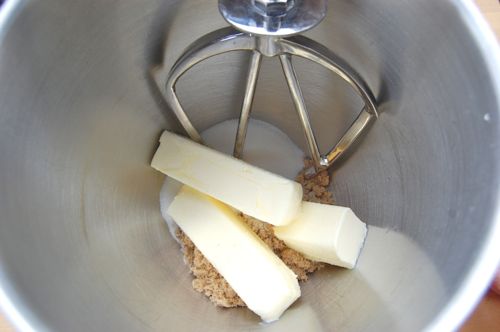
Beat that until it’s fluffy, then add the egg.

Beat on medium-high for about two minutes until the mixture is light and creamy.
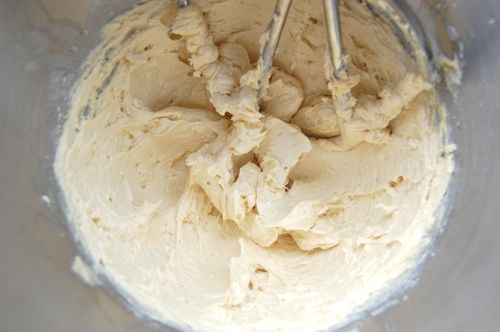
Scrape the bowl…
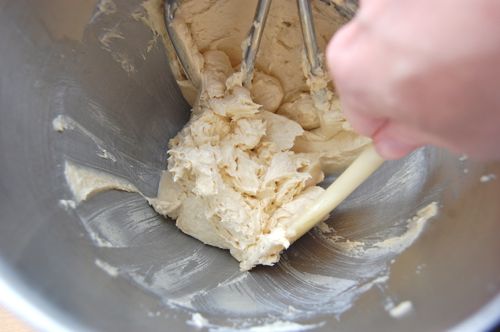
…and add the vanilla.
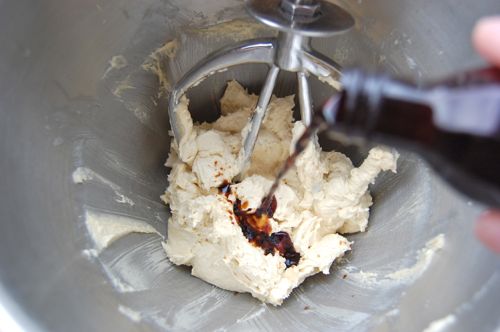
Beat that for another minute until…I guess it looks the same. Scrape the bowl again just to be safe.

Now add the dry ingredients in three additions, but stir the dough just until there’s only a little of the flour mixture showing. You don’t want to overmix this.
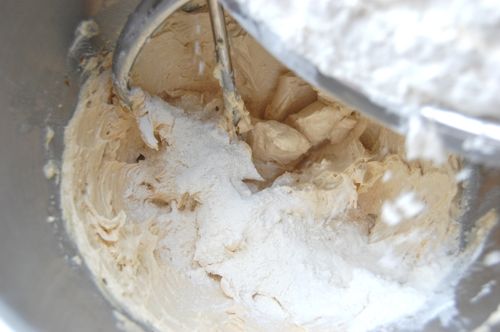
It’ll look about like so when you’re done:
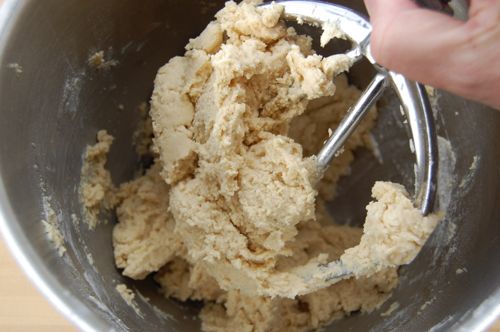
Now then, divide the dough in half and gently form the halves into balls (about 10 ounces each). Lay one of them on a sheet of plastic…
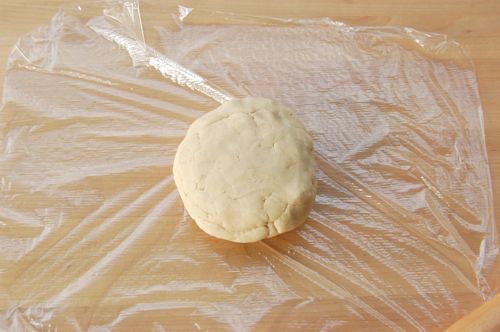
…cover with the another sheet…

…and gently roll the ball out to a roughly 8-inch circle, rotating the dough as you work. Repeat with the remaining dough and refrigerate the pieces for at least three hours, up to three days.
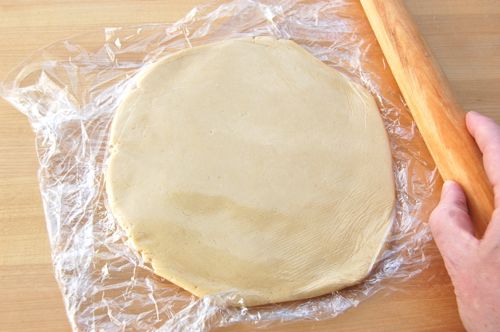
When you’re ready to shape the cake and bake, preheat your oven to 350 degrees Fahrenheit. Line an 8″ cake or springform pan with parchment paper. Meanwhile take the dough circles out of the refrigerator to let them soften a bit.

Grease it.
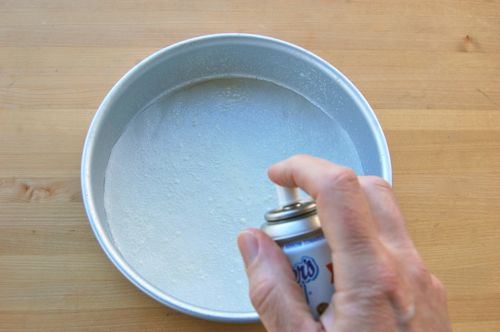
Remove the top sheet of plastic from one of the circles and flip the dough into the pan.

Press it into the corners.
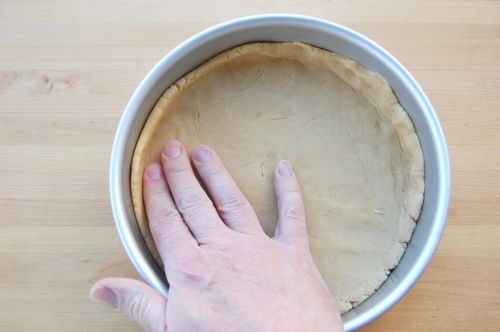
Now for the filling. Spread around about 3/4 cup of the black cherry preserves, leaving about a 1″ edge.
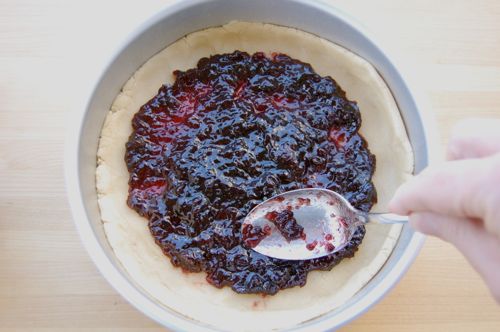
Then dip your finger in water and run it around the edge.
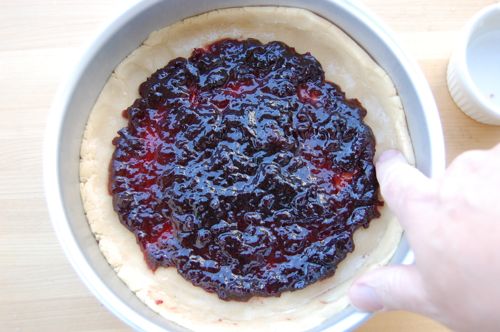
Now lay on the top crust.
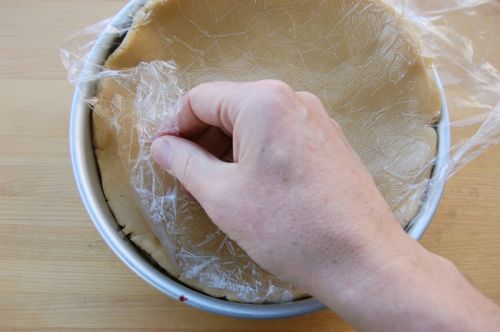
Poke that down around the edges…
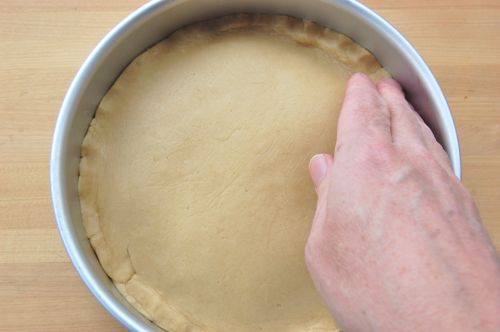
…then paint on some egg wash.

With a very sharp knife, score the top. Sets of three or four lines like this are traditional. Go straight across first…

…then at a diagonal.
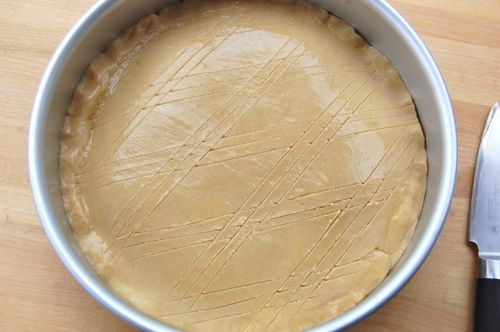
Bake the cake for about 45 minutes, until it’s well browned. This was my pastry cream-filled one. It cracked a bit due to expanding steam. Ah well, these things happen. Let the cake sit in the pan for about five minutes on a cooling rack, then run a knife around the edge to loosen in.

Place another rack on top, then flip everything over.

Remove the pan, gently replace the rack…
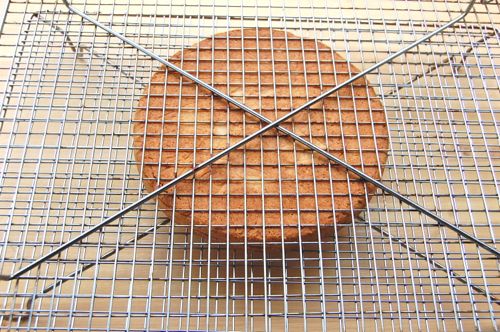
…and flip everything back over again. Remove the rack, let it cool down another half an hour, then slice and serve.

Now then, for the pastry cream-filled version of the cake, pipe (or spoon) about 3/4 cup of pastry cream onto the crust.
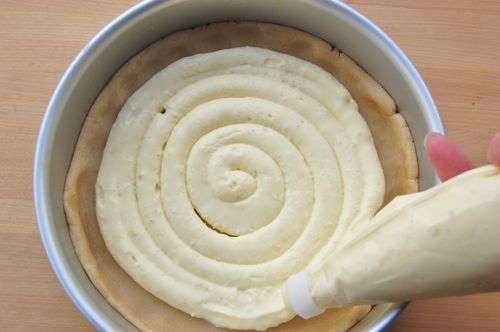
If you want to be French about it, (not Basque) add a few dollops of black cherry preserves in addition. Proceed as above.
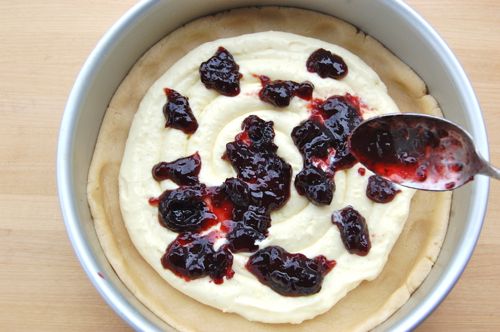
It will look about like so.
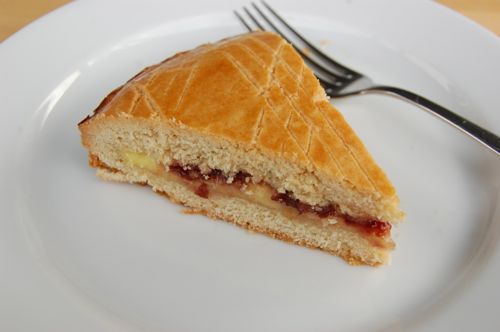
Some of you are surely wondering: which tastes better: the traditional single-filling gâteau Basque or the French-inspired combo? Well they’re both excellent. Ehem. However if pressed to answer I have to say…the French version. The pastry cream both moistens the very crumbly cake and mellows the black cherry perfectly.
But now I’ve gone and done it. Shortly Juan Carlos Aznar will be calling. He’ll force me to meet him on the field of honor in Basque Country where we’ll put on big shoes with balls on the toes, then ritually slap each other with fish until one of us cries out for mercy. Or whatever they do over there to settle disputes. I hear it’s something like that.
Ooooh! That is a thing of beauty!
What happens if you use Lemon Curd as the filling? Particularly with the pastry cream. Would I be inadvertently causing any sort of international event?
It should be delicious! You’ll have to justify yourself to Juan Carlos Aznar, of course. On your head be it! 😉
– Joe
Geez, I’m getting hungry from just looking at those photos. It’s already 1:30am so I suppose I shouldn’t quite snack…
Anyway, thanks so much for sharing the recipe! Can’t wait to try it 🙂
Let me now how it goes, April! Thanks for the comment!
– Joe
Hi Joe,
Just wondering about the brown sugar: in Europe it’s a completely different product than we get here in NA – as far as I understood, it’s what in NA is called unrefined/raw cane sugar. Principally from a cooking point of view, it doesn’t have the added molasses, with the result being that it is crystalline instead of soft. Lovely as a topping but I found it very different in batters. Which one should be used for this recipe? Thanks!
Hey Jen! Great question. Dorie Greenspan formulated this with American brown sugar in mind, so go ahead and use that. As I understand it in Basque Country they use an unrefined sugar that’s not unlike our turbinado sugar. Which is to say, it’s a product of the sugar cane refining and not sugar beet refining (which as you correctly point out, requires the addition of cane molasses to create a “brown” sugar). Real deal Basque-style sugar is very hard to find here in the States, and I do hate having to wait days/weeks to source and ingredient for a preparation I want to make today! 😉
– Joe
Thanks, Joe! It’s odd how certain ingredients haven’t really made the leap across the ocean in one direction or another: when I lived overseas, I was desperate for soft brown sugar, and here I’d love to have the crystalline kind! There were others too, but that one was really difficult to get around.
On this subject, any thought of putting together a “sugar series” (or maybe sweetener series?) to complement your very helpful flour and leavening sections of the site, and to help out those of us who sometimes find ourselves in other parts of the world and in need of understanding the effects of trading one ingredient for another?
VERY interesting idea there, Jen. I never thought of that. Could be fun! I’ll noodle it!
– Joe
I am so glad I checked your site before making my same old (still very delicious) poundcake for my Mom today. I wanted to make her something special and this gateau is something she will love… She prefers simple/refined desserts and it can be hard for someone like me (dip-everything-in-chocolate-and-cover-it-in-caramel type) to find recipes for her tastes.
Thanks for the inspiration, Joe!
Please do tell me how you like it, Amanda!
– Joe
Tried your recipe (cherry-preserve version) yesterday and it came out really good. Not too sweet , a bit on the dry side… both totally my cup of tea (ahem… I mean coffee :). Thanks, Joe.
Hehe…indeed. This is dry as pastries go, especially the version with just the preserves. However like you, I appreciate that. My daughters also loved it.
Thank you!
– Joe
Having Googled your version I am going to make it later this morning for my tasting panel ( I am first line quality control !).
Can’t wait 🙂
I am going to soak some prunes in brandy – that should be ok …
basque a la creme …..
Hips are expanding as I type this
Ha! Let me know how it goes. For the recipe, just go over to the left side menu and look up Gateau Basque under “Pastry”. It will be below the tutorial.
Let me know how it goes!
– Joe
But where is your actual recipe ?
Hi Joe,
I recently ate gateau basque for the first time in St Jean Pie de Port that was absolutely amazing. I came home and immediately looked up recipes to try it. I tried the Dorie Greenspan recipe with pastry creme. The cake we had in France was a bit lighter and there wasnt an obvious deliniation between cream and pastry. the layers blended together more. When looking at a slice you didnt see a defined pastry layer and cream layer. I wondered if you had a suggestion for trying to get the pastry lighter and more moist and to have the cream blend in to the cake more.
Thanks for any help you can provide or a link to a good recipe
Susan
Hi Susan!
Those French are cagey…always reinventing things. It could very well be that in this particular case the outside layers were more like a spongecake batter than a traditional gateau basque dough. That would explain both the lightness and the indistinct border between the two. If you’re up for an experiment, try lightening the final dough with a couple of stiffly beaten egg whites. Stir the first third in just to loosen the dough, then fold in the rest. Getting the top layer on might be a little tricky…but maybe you’ll want to pipe it if it’s loose enough, then smooth it with an icing spatula.
Get back to me with the results of your adventures!
– Joe
So excited to have found a recipe finally!! What is pastry cream??? It’s holding me back! Also i remember this cake being almond in flavour?
Hi Charlotte!
Just check the left side of the site, in those menus you’ll find “Pastry Components”. Pastry cream is right in there.
As for the almonds, there are all sorts of ways to add the flavor if you like. Use a proportion of almond flour…add almonds or almond flavor to the filling…the list goes on. Let me know how yours turns out!
– Joe
Hi Joe,
So I am a student writing a non-fiction paper about several french based and inspired desserts and their history. I am having trouble finding any background information on the Gâteau Basque other than a few different ways to make it. Do you know any history or other relevant information behind this dessert?
Thank you
Hello Celeste! What I know I put up back in February and March, you can access the archives on the bottom left. I actually got into some trouble with this subject when I wrote about Basque history, then about the swastika motif (lauburu) that’s frequently used to decorate the tops of these pastries. Oh well. Actually just about everything I put up on gateau Basque can be found at the end of February. Scroll down from here:
http://joepastry.com/2012/02/
Best of luck with the paper!
– Joe
What ingredients?
Hi Simon!
You clearly arrived by search engine. Here’s the recipe right here:
http://joepastry.com/category/pastry/gateau-basque/
Cheerio,
– Joe
Joe,
I had a slice of Gateau Basque at a fancy bakery near my house and was intrigued by the texture and the name, so I did some googling and ended up at your site. Your recipe doesn’t use almond flour which wikipedia claimed was a component. So, leaving aside the filling, I’m wondering what exactly makes this cake unique compared to a typical flour-eggs-sugar-butter cake… is it the proportions of the ingredients? The temperature and time in the oven? The way you mix it?
Hello Fahd!
I think there are a couple of unique things about gâteau Basque. One is the fact that it’s a filled, double-crust tart and you don’t see too many of those. Next the pastry cream and cherry — Basque country is known for its cherries — is something different as well. If you like you can add ground almonds to the crust, which is probably done in some places and would no doubt be a delicious compliment to the cherry preserves. Almond flour seems unlikely to me, but then I’ve been surprised before!
Good luck if you decide to try one!
Cheers,
– Joe